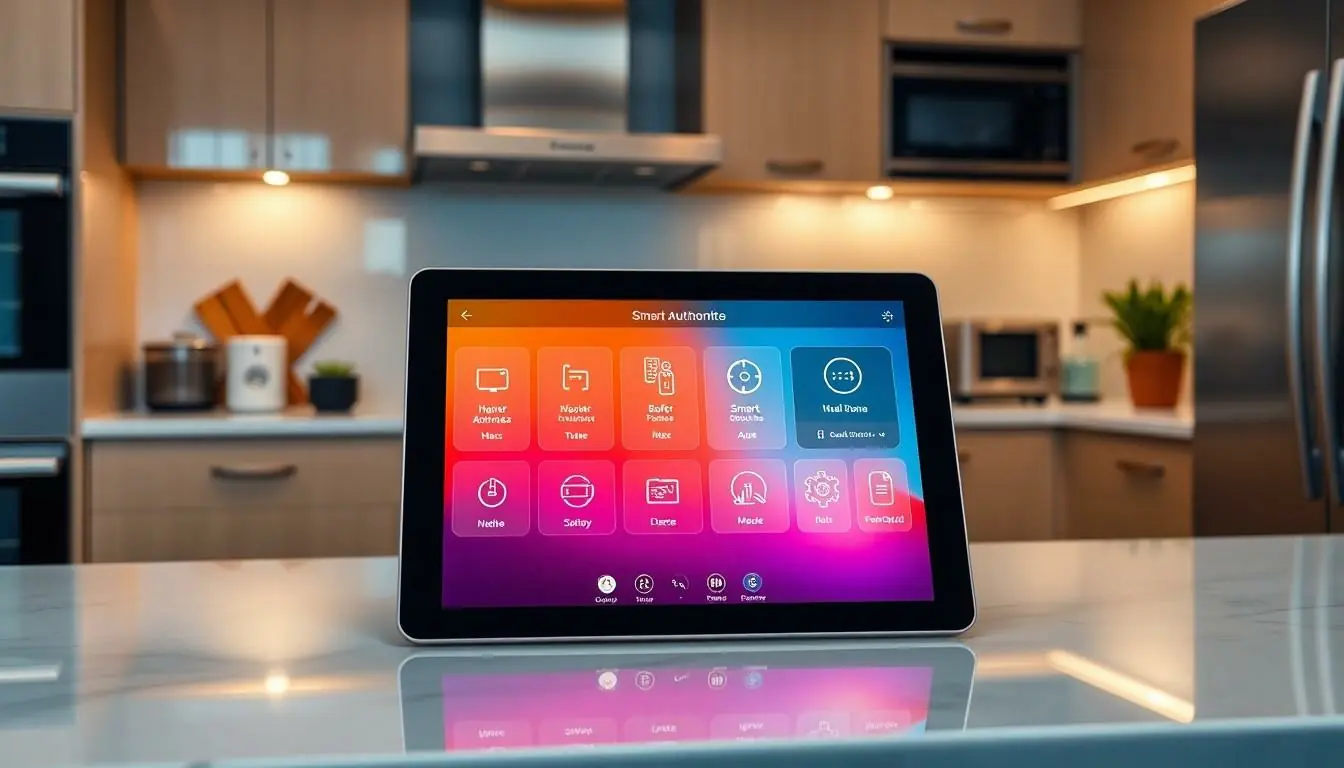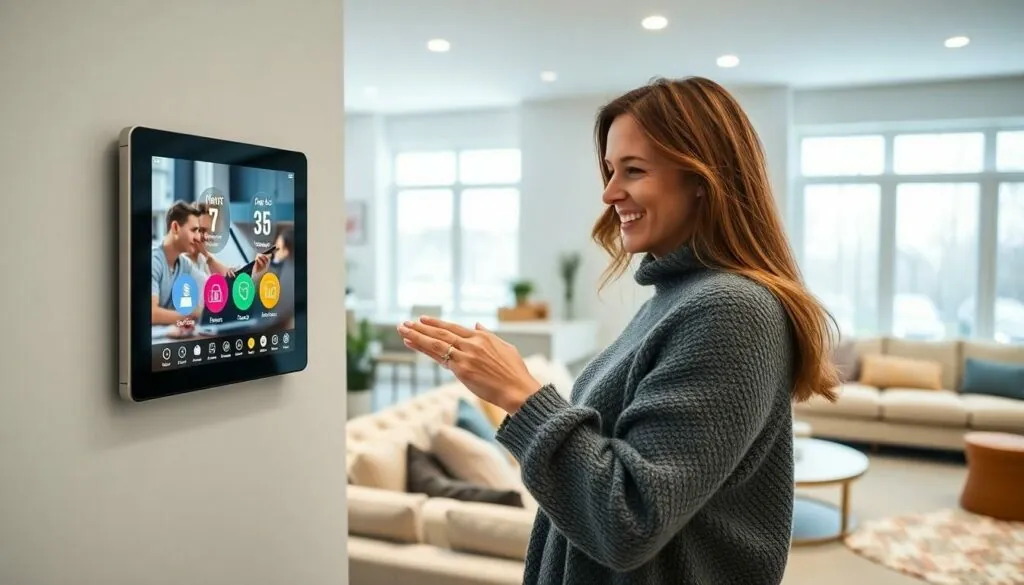Table of Contents
ToggleImagine walking into your home and having it respond to your every whim—lights dimming, music playing, and the thermostat adjusting, all at your command. With a home automation tablet, this isn’t just a dream; it’s a reality that’s easier than finding your car keys in the couch cushions.
Overview of Home Automation Tablets
Home automation tablets serve as central hubs for managing various smart devices in a home. These devices enable seamless control over lighting, temperature, security, and entertainment systems. Integration of multiple functionalities into a single tablet enhances user experience by simplifying interactions with several home automation systems.
Such tablets typically run on popular operating systems like Android or iOS, offering compatibility with a wide range of applications. Users can easily download the relevant apps to connect different devices, streamlining the management process. Customizable dashboards provide personalized controls, allowing for quick access to frequently used settings.
Many tablets feature touchscreens that enhance usability, offering intuitive navigation through simple gestures. Voice control functionalities are also common, enabling hands-free operations and enhancing accessibility. With high-quality displays, many home automation tablets allow users to view real-time camera feeds or access security alerts, ensuring peace of mind.
Connectivity options often include Wi-Fi, Bluetooth, and Zigbee, fostering compatibility with numerous smart devices. Integration with voice assistants like Amazon Alexa or Google Assistant further extends functionality, enabling voice-activated commands. Home automation tablets come with security features that protect user data while providing reliable software updates.
Purchasing a home automation tablet involves considering specifications like processor speed and battery life to ensure optimal performance. Price points vary depending on features and capabilities, making it easier for users to find suitable options for their needs. Brands like Google, Amazon, and Samsung offer popular models, each with unique strengths.
Key Features of Home Automation Tablets

Home automation tablets provide essential functionalities for modern smart homes, enhancing user interaction and device management.
User Interface and Experience
A user-friendly interface plays a crucial role in home automation tablets. Intuitive navigation enables users to control various devices efficiently. Touchscreen functionalities enhance engagement by allowing simple swipes and taps. Customizable dashboards make it easy for individuals to organize frequently used applications. Accessibility options expand usability for all users, ensuring everyone can interact with the system effectively. Updates often improve functionality and introduce new features, keeping the tablet relevant over time. Voice control adds a hands-free element that simplifies operations, catering to those who prefer an effortless approach.
Compatibility with Smart Home Devices
Compatibility with multiple smart home devices is vital for a home automation tablet. These tablets typically support popular protocols such as Zigbee, Z-Wave, and Wi-Fi, maximizing communication with various devices. Enhanced integration capabilities allow seamless connections with lighting systems, security cameras, and thermostats. Users can control diverse devices from brands like Philips Hue, Nest, and Ring without hassle. A broad range of supported devices ensures flexibility in home automation setups. Regular software updates can often improve compatibility, expanding the device range for enhanced user experience.
Popular Home Automation Tablets on the Market
Several reliable tablets provide impressive features for home automation. These devices enable seamless control over various smart home systems and enhance user experience.
Tablet A: Features and Performance
Tablet A boasts a bright, high-resolution touchscreen, delivering sharp visuals for streamlined navigation. This model integrates with popular voice assistants, allowing voice-activated control for hands-free convenience. Battery performance stands out, offering up to 12 hours on a single charge, making it ideal for all-day use. With robust processor capabilities, users enjoy smooth performance when multitasking between apps. Security features, including facial recognition, enhance user privacy while providing peace of mind.
Tablet B: Features and Performance
Tablet B features a durable design and is known for its compatibility with numerous smart home devices. Voice control options enable effortless interaction while maintaining functionality across various platforms. The tablet’s vibrant display supports a customized dashboard, reflecting a user-friendly interface. Hardware specifications include a powerful processor and ample RAM, ensuring responsive performance. Regular software updates extend device longevity, making it a smart investment for future-proofing home automation setups.
Tablet C: Features and Performance
Tablet C represents a versatile option with advanced connectivity, supporting Wi-Fi, Bluetooth, and Zigbee protocols. Users can manage multiple smart devices seamlessly through a singular interface. A highly responsive touchscreen enhances navigation, while built-in speakers offer quality sound for entertainment purposes. This tablet’s lightweight design ensures portability, allowing users to control their home systems from anywhere. Battery longevity of around 10 hours ensures adequate usage time throughout the day.
Benefits of Using a Home Automation Tablet
Home automation tablets streamline control over various smart devices, enhancing user convenience significantly. Simple adjustments to lighting, temperature, and security occur at one touch, making daily tasks easier. Ease of access to all connected systems fosters a seamless home environment.
User-friendly interfaces simplify navigation for all ages. Voice control features empower users to operate devices hands-free, adding another layer of convenience. High-resolution touchscreens offer an engaging experience, making interactions intuitive and enjoyable.
Integration with popular protocols like Zigbee, Z-Wave, and Wi-Fi ensures compatibility with numerous devices. These tablets support a diverse range of smart home products, from lighting systems to security cameras, allowing comprehensive management. Regular software updates maintain functionality and improve device interoperability.
Customizable dashboards enable users to tailor their experience according to personal preferences. The ability to prioritize frequently used settings enhances efficiency in everyday tasks. Security features add peace of mind, protecting sensitive data from potential threats.
Tablets designed for home automation often come equipped with advanced connectivity options. Wi-Fi, Bluetooth, and Zigbee capabilities circulate information seamlessly between devices. Many tablets readily integrate with voice assistants like Amazon Alexa or Google Assistant, further enriching the user experience.
With numerous options available in the market, each tablet offers unique advantages. Some models highlight impressive battery life, while others excel in durable designs or vibrant displays. Users can find various models that cater specifically to their needs, ensuring satisfaction in managing smart home systems.
Considerations Before Purchasing a Home Automation Tablet
Purchasing a home automation tablet involves several key factors. First, evaluate compatibility with existing smart devices. Ensure the tablet supports popular protocols such as Zigbee and Z-Wave, as these create seamless connections within smart home systems.
Next, consider user interface features. A simple and intuitive interface enhances usability, making it easy for everyone in the household to navigate. Voice control options add convenience, allowing hands-free operation.
Look into the tablet’s operating system. Android and iOS are the most common, with each offering unique applications for managing smart devices. Assess the availability of relevant apps that align with personal automation needs.
Battery life plays a vital role as well. Opt for tablets that offer long battery performance to avoid frequent recharging, especially when used as a central command hub for numerous devices.
Display quality cannot be overlooked. High-resolution screens improve visibility and engagement, making managing home settings visually appealing and straightforward. Touchscreen functionalities should provide responsiveness.
Security features also warrant attention. Strong security measures protect personal data from unauthorized access, keeping the smart home environment safe.
Brand reputation contributes to product reliability. Established names such as Google, Amazon, and Samsung are known for their quality and support, ensuring users receive assistance when needed.
Finally, factor in price and available models. With numerous options, users can select tablets that meet specific needs without overspending. Prioritizing these considerations ensures a smart home tablet enhances automation experiences effectively.
Home automation tablets are transforming how individuals interact with their living spaces. By providing a centralized hub for managing smart devices, these tablets enhance convenience and efficiency in everyday tasks. With intuitive interfaces and advanced functionalities, they cater to diverse user needs while ensuring seamless compatibility with various smart home products.
The right home automation tablet can significantly elevate the smart home experience, making it more accessible and enjoyable. As technology continues to evolve, these devices will only become more integral to modern living, offering innovative solutions for a connected lifestyle. Investing in a quality home automation tablet can lead to a more responsive and personalized home environment.



